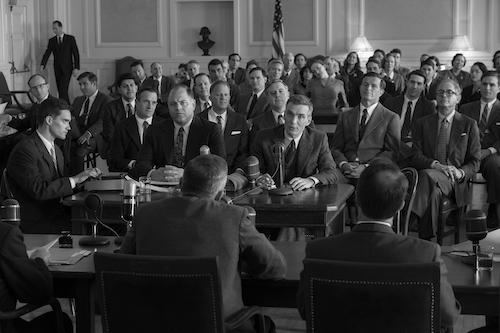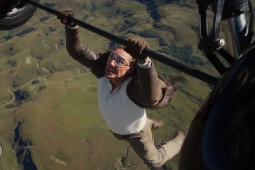
Christopher Nolan doesn't simply make movies, he makes experiences. His latest epic Oppenheimer is a case in point: a dense, teeming and arresting account of the Manhattan Project and the development of the atomic bomb. It's anchored by a sensational lead performance from Cillian Murphy as scientist J. Robert Oppenheimer, is clad in arresting scope by Hoyte van Hoytema and is adorned with a forceful, propulsive score from Oscar winner Ludwig Goransson.
Evidently, a movie of this size and scale that deals with such weighty themes demands a special viewing experience. We're talking IMAX here: Nolan and Hoytema shot the movie on IMAX cameras, using a combination of 65mm film and 65mm large format film, to really take the breath away. The resolution and clarity resulting from the IMAX remastering process throw Oppenheimer's achievements and tragedies into sharper relief as he reckons with the destructive power of his own creation.
We're speaking to the people who have already experienced the movie in IMAX and can't wait to go again, as well as also those who are experiencing serious FOMO. Here are the Oppenheimer IMAX sequences that cement Nolan as one of cinema's great contemporary visionaries.
Oppenheimer's days at Cambridge
The early sequences in Oppenheimer are akin to Stephen Hawking biopic The Theory of Everything, communicating a profound sense of a brilliant scientific mind that is not quite in lockstep with the rest of the world. IMAX makes Oppenheimer's internal thought processes, however brief, seem all the more grandiose and profound, amplifying Nolan's decision to depict scurrying atoms that rage like so much scientific theory inside his head.
One need not think of theory as a purely academic or verbal conceit. Nolan, his cast and crew make it visual and visceral, anticipating Oppenheimer's mercurial and tenacious nature that will ultimately see him participate in the Manhattan Project.
The development of the Los Alamos site
The Manhattan Project famously set down its roots in Oppenheimer's beloved New Mexico desert in Los Alamos. The details of the construction of the atomic site are classic Nolan, ranging in a typically assured manner from wide establishing shots to intimate cuts on faces. When experienced in IMAX, the movie's wider principles become clear: this is a movie both with an eye on technical construction and also the human cost behind that construction.
Take the moment when Oppenheimer's wife Kitty (Emily Blunt) is first driven to the site. Even if its scale has dwarfed and impressed us as an audience, Blunt's intuitive features effectively bring us back down to Earth, conjuring a sense of intimidation and apprehension resulting from this epochal moment in human warfare.
The Trinity test
This is the movie's centre-piece, a showstopper sequence that validates one's need to experience Oppenheimer in IMAX-sized dimensions. Much has been made about how Nolan and his effects team recreated the landmark Trinity Test, the controlled atomic explosion that ultimately informed the attack on Hiroshima and Nagasaki in Japan, even when it was evident that the Nazis, against whom the Manhattan Project was racing, were on the verge of surrendering.
Nolan is famously averse to using CGI unless it's absolutely necessary, and that characteristic sense of physical veracity radiates through the nerve-shredding sequence. Beginning with the placement of the bomb at the top of the tower, taking in the famous image of Oppenheimer donning the goggles and culminating in an eerily distanced firestorm that eventually yields a startling, vicious shockwave, all connected by the insistent percussive menace of Goransson's score, this is grandiose practical filmmaking that demands a grandiose visual presentation.
In the hands of another filmmaker, this could have been a by-the-numbers staging of a pivotal moment that lacked any kind of heft. The IMAX presentation, however, elevates it into a physically imposing series of events that tell us one thing: mankind would never be the same after this moment, and we're meant to feel that in our bones.
Hearing of the attack on Japan
Who says IMAX needs to always be harnessed in the service of landscape shots? Nolan is smart enough to realise that human faces offer their own kind of landscape, replete with nuances, grooves and valleys that communicate an array of complicated information. This is where Murphy becomes the movie's secret weapon: his arrestingly gaunt features transmit a combination of intuitive intelligence, underlying hubris and, ultimately, fearful horror as he finds himself at an emotional remove from the impact of the atomic bomb.
This is chillingly evident in the wake of the Trinity Test as Oppenheimer learns of the consequences of the Hiroshima and Nagasaki attack over the radio. There's no need to gratuitously labour over a historical re-enactment of the tragic event. The scope of IMAX turns Murphy's face into the kind of canvas that tells us everything about what has happened and what is due to happen, anticipating his later anxiety over the development of the H-Bomb.
The final outcome between Oppenheimer and Strauss
As we approach the film's emotionally thunderous climax, Jennifer Lame's skillful editing and intercutting bear all the hallmarks of Nolan's previous movies. He encourages blunt and often abrupt transitions between scenes across multiple timelines, intentionally compelling audiences to keep up amidst myriad characters, ideologies and plot developments.
When coupled with Hoytema's handsome visual aesthetic and the keening impact of Goransson's score, we get a profound sense of things at stake even when the immediate consequences of the atomic bomb have apparently been relegated to the background. The scale and sharpness of IMAX enhance the sense of two very different men, Oppenheimer and his political nemesis Lewis Strauss (a terrific Robert Downey Jr.), on an ideological collision course of mutually assured destruction.
Aesthetically speaking, the specifications of IMAX transfigure an intimate rivalry between two men into a vast operatic tapestry that spills over into the public eye and the US Senate, extending both its visual and auditory impact. The end result? Two individuals who obliterate each other's lives as we're left to ponder the chilling notion that Oppenheimer and Albert Einstein's fearful predictions about the bomb itself have indeed come true.
Can't wait to experience Oppenheimer in IMAX for the first or second time? Click the link below to get your tickets for the movie.














.jpg)
.png)



